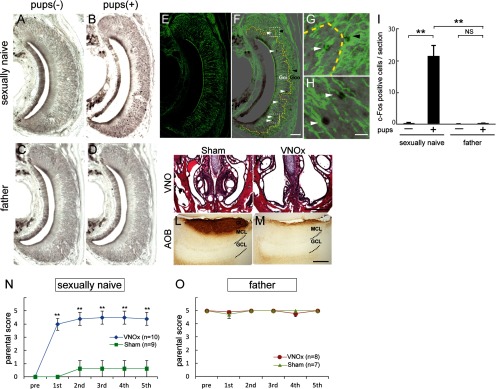Figure 4.
A crucial role of the VNO in the attack-to-parenting transition in male mice. A–D, c-Fos expression (black) in VNO of sexually naive males (A, B) and fathers (C, D) in control condition (A, C) and after pup exposure (B, D). E–H, Double immunostaining of VNO section from sexually naive male mouse for c-Fos and Gαo. E, Gαo expression (green) in the same section as B. F, Merged image of B and E. White and black arrowheads denote c-Fos-positive/Gαo-negative and c-Fos-positive/Gαo-positive neurons, respectively. G, H, Enlarged views marked in F. I, Quantification of c-Fos-positive VSNs in sexually naive males and fathers with and without pup exposure (n = 6). Welch's ANOVA revealed a significant difference among groups (F(3,9.24) = 12.84, p = 0.001). Data are represented as mean ± SEM. **p < 0.01 (Welch's t test followed by correction with Holm's method). J–M, Surgical ablation of VNO. J, K, Coronal sections of the skulls from sham-operated (J) and VNO-ablated (VNOx) (K) mice stained with hematoxylin and eosin. L, M, Parasagittal sections of the AOB from sham-operated (L) and VNO-ablated (M) mice labeled with horseradish peroxidase-conjugated soybean agglutinin (brown). N, O, Effect of VNO ablation (blue in N, red in O) on the pup-directed behaviors in sexually naive males (N) and fathers (O). The number of subjects is shown on the graph. Males' behaviors toward pups are plotted as parental scores. **p < 0.01 (Mann–Whitney's U test). Scale bars: F, 50 μm; H, 10 μm; M, 200 μm.

